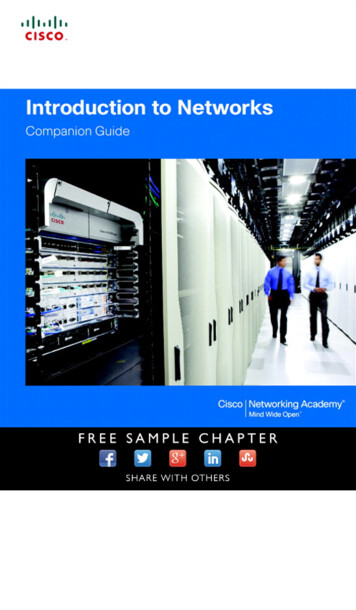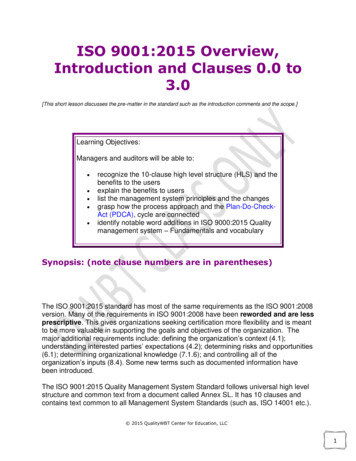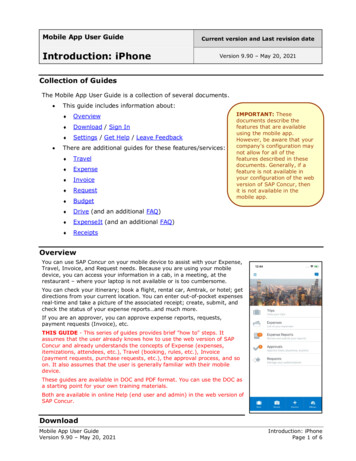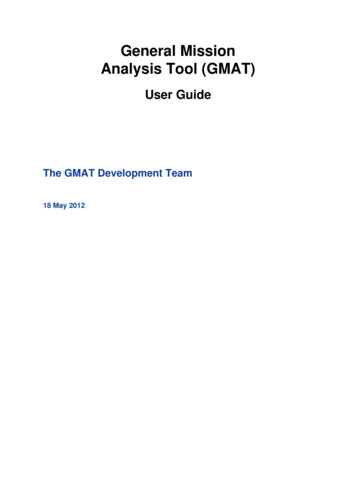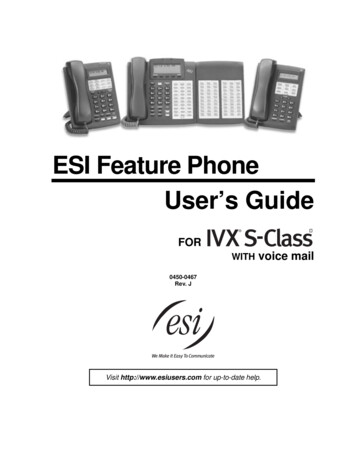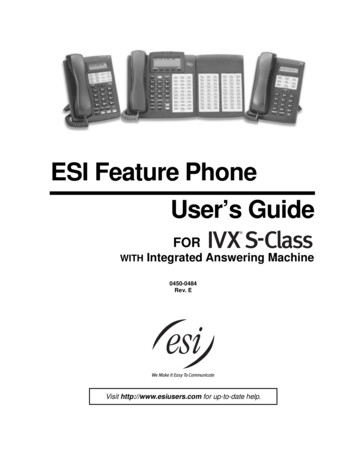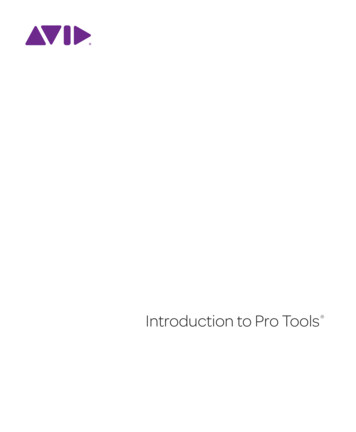
Transcription
THE DEAFAn Introduction andGuide to SharingChrist withthe Deaf
AN ANSWER TO OUR OWN PRAYERHave you ever found as you lifted up a particular concern before the Lord, that God nudgedyou to be a part of His answer to your own prayer? In recent years, as we’ve asked the Lordto raise up more workers to serve in His harvest fields, He has laid one group on our heartsover and over: the Deaf who live among Buddhist, Hindu and Muslim peoples. And now,He’s allowed us to be a part of reaching these often unnoticed and frequently marginalizedcommunities.The vast majority of the Deaf around the globe have no access to the treasure we hold inJesus Christ. Just 2% have been introduced to the good news, and many live in parts of theworld mostly or completely untouched by the gospel.Many of these least-reached people are separated from the larger Hearing society aroundthem, and as a result have even fewer opportunities to learn of the good news. In somecultures, being deaf is seen as a curse, and members of the Deaf community are neglected byand isolated from those who can hear. Furthermore, misconceptions about the Deaf oftenprevent believers from seeking to reach them with the good news.Simply bringing the gospel to the places where the Deaf live isn’t enough. Because Deafcommunities have distinct sign languages, cultures and worldviews, to effectively reach them,we need to send followers of Christ who can be accepted in Deaf society, respect theirunique gifts and challenges and communicate the good news in their sign languages.We’re thrilled that Christar workers devoted to ministry in Deaf communities are now onthe field! By God’s grace, we eagerly anticipate seeing many more begin serving among theseleast-reached people.We desire to plant churches among the Deaf who are living amid populations of Muslims,Hindus and Buddhists for the same reason we serve among Hearing peoples: God haspromised there will be people from every nation, tribe, people and language (including signlanguages) worshiping around the throne of God. We align ourselves with the promise thatsalvation in Christ is not just for the Hearing, but for the Deaf as well.Sincerely,Dr. R. Stephen CoffeyDirector, Christar U.S.
OPEN DOORS TO REACH THE DEAFAmong the approximately 70 million people worldwide who use a sign language as theirfirst or primary language, 98% are least-reached: They don’t have access to a churchthat preaches the gospel in their language and worships in a way that’s relevant in theirculture. Unless followers of Christ bring the good news to them with an approach and ina language they can understand, they won’t have the opportunity to know and worshipour Savior.Just 2% of the Deaf worldwidehave been introduced to Jesus.Although we sense the urgency of bringing the gospel to all least-reached people, thepresent is a particularly opportune time to reach the Deaf. In years past, it wasn’tpossible to share the gospel with the Deaf in their heart language without having aface-to-face conversation. Now, technology has made it possible to communicate thegospel to the Deaf across distances, through means such as video and online networking.In addition, God is giving many Deaf believers in developed countries a burden to reachother Deaf, both in their communities and around the world. And, in recent years, Godhas increased awareness of the Deaf among Hearing believers and burdened them tosee the Deaf also know and worship Jesus.1
COMMON MYTHSIt’s likely that only 5% of the estimated 400 sign languages worldwide have any Scriptureportions available. So, especially among the Deaf, it is imperative that believers buildrelationships and personally share the good news in culturally relevant ways. With newerchannels of communication like video and online networking, opportunities to communicate the gospel are opening as never before.However, misunderstandings about the Deaf often prevent Christians from workingto share the gospel among them. Even in places with many followers of Christ, Deafcommunities can remain isolated from the gospel. Often the Deaf are “hidden leastreached”: without access to a church that proclaims the gospel in their language andworships in their culture, even if those in the surrounding Hearing community haveopportunities to learn about Jesus.2
Misconceptions About Reaching the DeafMyth #1: The Deaf can just read the gospel.Although some Deaf people are able to read, many struggle to fully understand writtenmaterials. Written languages are based on spoken languages, which the Deaf have neverheard. As a result, it’s inherently more difficult for them to read as they’ve never heardthe sounds that letters symbolize. They can’t “sound out” words and instead mustlearn to recognize combinations of letters, almost like memorizing a phone number foreach word.In addition, sign languages have unique structures and idioms—they’re not word-forword translations of spoken languages. Even when Deaf people can read the writtenform of the language spoken where they live, it is still a “foreign” or “second” language tothem—not the language of their hearts!Myth #2: The Bible is available in sign language.At least 95% of sign languages have no Bible translation. Unless believers communicatethe gospel to the Deaf in their language, they can’t learn of the hope of Christ throughthe means of communication that is most accessible to them.Myth #3: All Deaf people use the same sign language.Each of the hundreds of sign languages used around the world has its own uniquestructure and figures of speech. To reach all of the Deaf worldwide, the gospel needs to becommunicated in all of these languages, through believers who enter Deaf communitiesand through the Bible translated into each of these languages.Myth #4: Ministries to the Hearing also reach the Deaf.Even if a Deaf person has access to printed Scripture and lives in a place with manyChristians, there’s a good chance he or she hasn’t been introduced to Jesus. Although theDeaf may look like the Hearing people in the surrounding community, they don’t identifywith the culture of that community. Just as we don’t expect members of Muslim, Hinduand Buddhist communities to cross cultures in search of the good news, we don’t expectthe Deaf to seek the gospel outside of their culture. Followers of Christ must enter Deafcommunities and share the message of Christ in relevant ways.Often the Deaf are “hidden least-reached.”3
REFLECTING JESUSto a Deaf NeighborLike all people who don’t yet know the hope of Christ, the Deaf need to see Himreflected in the lives of His followers. Although members of the Hearing communitycan’t share the gospel in the language of their Deaf neighbors’ hearts without learning tosign, they can demonstrate the love and compassion of the God who sent His Son forthem. The following tips can help you relate to a Deaf person in a way that’s respectfuland considerate, allowing you to be a reflection of Jesus and represent Him well.Let Them Take the LeadYour Deaf neighbor likely navigates communication with the Hearing community on aregular basis, and knows what works for him or her. Follow your neighbor’s lead, seekingto do what’s comfortable for that person. If you’re not sure what’s helpful and what’s ahindrance, don’t be afraid to ask!Be PreparedIf you know your neighbor prefers to communicate with you through writing, beprepared! Carry a pen and paper or a tablet on which your neighbor can type, rather thanexpecting him or her to have writing implements on hand. Other forms of electroniccommunication such as texting, Facebook messaging, emailing or simply typing text onyour cell phone and passing it back and forth can also be helpful tools in connecting withsomeone who prefers to communicate with the Hearing through writing.4
Make Eye ContactEye contact is a foundation for effective communication, and it’s often especially importantin Deaf communities. Since the Deaf communicate visually, breaking eye contact during aconversation with a Deaf person is like covering your ears while speaking with a Hearingperson. Be sure to look your neighbor in the eye.Be VisiblePosition yourself directly in front of the person, and make sure he or she is looking at youbefore you begin to communicate. (If you need to get a Deaf person’s attention, try asimple tap on the shoulder.) If it’s within your control, make sure there’s adequate lighting.Speak NormallyIf you’re interacting with someone who reads lips, speak at a normal pace and volumeand don’t over-enunciate—exaggerating your speech can make it harder for your friendto determine what you’re saying. Be sure to keep your hands and any objects awayfrom your mouth, and don’t eat, drink or chew gum while you’re speaking. Keep in mindthat only about 30% of speech can be read on the lips, and be prepared to use othermeans of communication if the Deaf person requests it—remember, let him or her takethe lead!Be PatientMany times, it can take a while to figure out the best means of communication, and evenlonger for it to feel comfortable. Be patient! Taking the time to determine how the two ofyou can have an effective conversation is a way to demonstrate that your Deaf neighbor—and what he or she wants to communicate—is important to you.If you’re having trouble getting your point across or don’t understand what your neighboris trying to say after several tries, don’t brush it off! Comments like “don’t worryabout it” or “it wasn’t important” may be well-intentioned, but they convey thatcommunicating with your friend isn’t worth the effort, and are considered a major insult.Share Resources in Sign LanguageHelp your Deaf friend learn about the gospel by sharing resources that communicateit in sign language. Websites like deafbibles.com and deaf.bible offer Bible stories andScripture that can help your friend understand the good news.Be a FriendApart from the differences in language, building a friendship with a Deaf person happensthe same way as getting to know a Hearing person. Look for common interests andopportunities to be kind. Invite them to join you at a football game, share a batch ofcookies or help your neighbor rake leaves. Remember him or her at Christmas and otherholidays. Ask God to give you opportunities to be a friend and to make Himself visiblethrough you.5
CHRISTAR’S MINISTRYAs followers of Christ, we have a treasure in God and His kingdom. The good news isthat this treasure is not limited to certain places or people. It is for all peoples—fromevery language, people group and nation. At Christar, it is our joy to communicate theunsurpassed value of this treasure by serving the needs of others through our lives,professions, skills and words.Christar is motivated by a passion to establish churches among the least-reached. Wetrust the Lord to work through us as we send teams to cultivate Christ-honoringtransformation in Deaf communities throughout the world where He is not yet knownor worshiped.“The harvest is plentiful but the workers are few. Ask the Lord of theharvest, therefore, to send out workers into his harvest field.”Matthew 9:37b-38 (NIV)6
Building on a Heritage of Serving the Least-ReachedThrough the Deaf Initiative, Christar is expanding its church-planting efforts to includereaching the Deaf with the good news. God has already begun to bring workers toChristar to serve among these least-reached people. We’re seeking more believerswith the passion, call, language skills and Deaf culture experience to join teams alreadyworking among Hearing peoples and begin reaching out to Deaf communities withinthe same regions. To do that, we need to develop a dedicated mobilizing team toidentify candidates. We’re asking God to call many new workers so we can do amongthe Deaf what we have been doing for since 1909 in other communities: cultivatingChrist-honoring transformation where He is not yet worshiped!We’re thankful for increasing efforts by various agencies to translate the Bible into signlanguages. And we praise God that numerous organizations are reaching the Deaf withthe gospel. It’s our joy to join the movement and to plant churches in Deaf communitiesliving among Buddhists, Hindus and Muslims.7
WHAT NOW?Partnering With Christar to Minister Among the DeafPray: Ask God to raise up workers with a passion to reach the Deaf and the abilityto enter least-reached communities.Pray that believers in Deaf churches will have a burden for Deaf communitiesaround the world.Ask God to enable Christar to effectively collaborate with other organizationsministering among the Deaf.Pray for open doors for ministry in Deaf communities.Pray for wisdom as Christar seeks to effectively bring the gospel to Deafcommunities.Ask God to provide the funds needed to launch this critical new outreach.Go:We’d love to talk with you about how God could use you for His glory amongthe Deaf! Give us a call at 214-838-3800 or email us at go@christar.org.Give:Your gift to the Deaf Initiative will help Christar identify and train new workersto serve among the Deaf, helping us launch this new outreach to these hiddenleast-reached people. Go to christar.org/deaf-initiative to learn more.8
Helpful ResourcesBelow are selected resources on the Deaf and ministering among them. The followingaren’t a replacement for active involvement with Deaf individuals and the wider Deafcommunity, but they can serve as good starting points for understanding the Deaf andlearning sign language.For more, visit christar.org/deaf.Websites:American Sign Language Nook (ASLNook.com): Teaches American Sign Language to allages, including young children, through videos created by a Deaf family.American Sign Language University (lifeprint.com): Provides an enjoyable way to learnAmerican Sign Language, originally designed for use in conjunction with college-levelASL classes.Deaf Bible (deafbibles.com): Provides videos of God’s Word in the sign languages of eightcountries.Deaf Bible Society (deafbiblesociety.com): Offers the Deaf Bible app and online Bible, aswell as information about the Deaf.Door International (doorinternational.org/why-deaf): An organization seeking to bringGod’s Word and reproducing Christian fellowships to the Deaf of the world; providesinformation on the Deaf and reaching out to them.Handspeak (handspeak.com): Offers American Sign Language resources that include adictionary and tutorials.World Federation of the Deaf (wfdeaf.org): A global organization that works to ensureequal rights for the Deaf around the world.App:The ASL App (theaslapp.com): A free mobile app that teaches conversational AmericanSign Language.Books:Understanding Deaf Culture: In Search of Deafhood, by Paddy Ladd. Multilingual Matters,2003.For Hearing People Only: Answers to Some of the Most Commonly Asked Questions Aboutthe Deaf Community, its Culture, and the “Deaf Reality,” by Matthew S. Moore and LindaLevitan. Deaf Life Press, 2003.Inside Deaf Culture, by Carol A. Padden and Tom L. Humphries. Harvard University Press,2006.9
Christar U.S.P.O. Box 851377, Richardson, Texas 75085-1377214-838-3800 info@christar.org christar.org facebook.com/christarusa twitter.com/christarusainstagram.com/christarusa pinterest.com/christarusa 2022 Unauthorized use and/or duplication of this material without written permission from Christar is strictly prohibited.Images are representative.Scripture taken from the Holy Bible, NEW INTERNATIONAL VERSION , NIV . Copyright 1973, 1978, 1984, 2011 by Biblica,Inc. Used by permission. All rights reserved worldwide.Quran references are from The Holy Quran, translated by Abdullah Yusuf Ali. (New Delhi: Goodword Books, 2003).Statistics regarding the world Muslim population taken from the Pew Research Center (pewresearch.org).Statistics regarding least-reached people taken from Joshua Project (joshuaproject.net).0622Printed in the U.S.A.
Myth #2: The Bible is available in sign language. At least 95% of sign languages have no Bible translation. Unless believers communicate the gospel to the Deaf in their language, they can't learn of the hope of Christ through the means of communication that is most accessible to them. Myth #3: All Deaf people use the same sign language.


